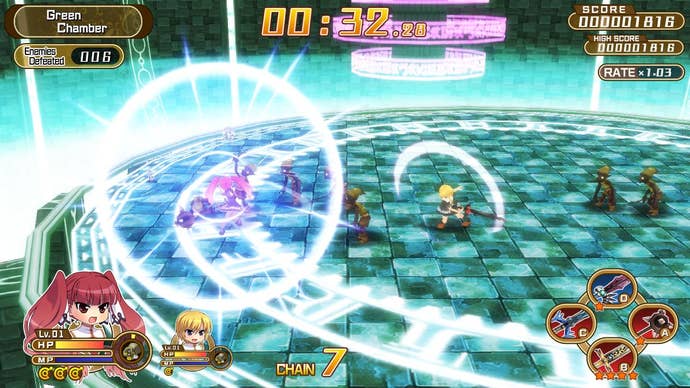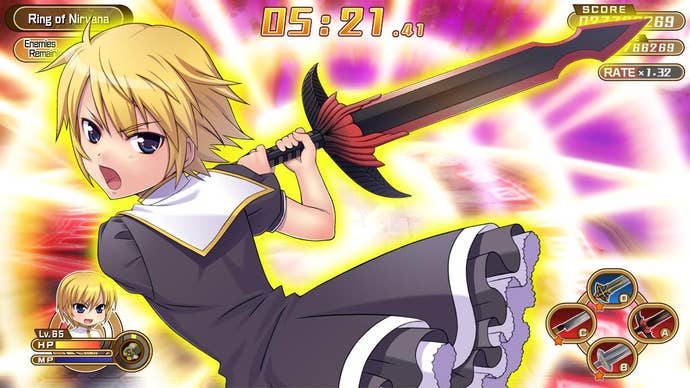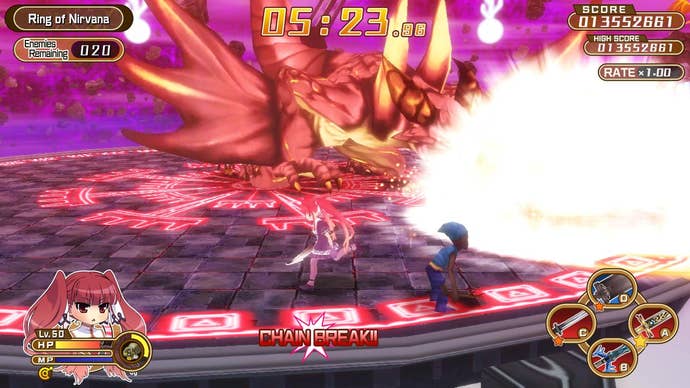JPgamer: A First Look at Croixleur Sigma
Sporting possibly the least-pronounceable name in video game history, Nyu Media's latest release on Steam, out today, is an enhanced version of a doujin hack-and-slash title. Is it worth your time?
This article first appeared on USgamer, a partner publication of VG247. Some content, such as this article, has been migrated to VG247 for posterity after USgamer's closure - but it has not been edited or further vetted by the VG247 team.
Before we start: no, I don't know how to pronounce "Croixleur." I have enough trouble saying "croissant" without embarrassing myself, so I'm not even going to try with this one.
Ahem. Anyway. Croixleur Sigma is an enhanced rerelease of a Japanese doujin title that first came to Western shores courtesy of Nyu Media early last year. It's a hack-and-slash action game perhaps most simply described as "Robotron with swords," and in its original incarnation, it was a lot of fun, if a little limited in scope with regard to enemy and level design. A year later, it's still a lot of fun, if a little limited in scope with regard to enemy and level design, but there's a whole bunch of extra new bits bolted on to the base experience, too.
The story revolves around two young girls: spunky twintailed redhead Lucrezia and the super-serious Francesca, both prodigies from the land of Ilance representing the Aristocrat and Knight factions respectively. Lucrezia and Fran are thrown into the "Adjuvant Trial," a traditional ritual held since the founding of Ilance in which representatives from the two factions battle to determine who will hold military and political authority and, by extension, protect the Queen. Said trial takes the form of a series of arenas in which our heroines must fight their way through hordes of monsters in an attempt to prove their supremacy.

The narrative is pretty throwaway, but it does help both your playable character and your rival -- you can play as either Lucrezia or Francesca once you've unlocked them both -- feel like actual characters rather than simple avatars for all the death and destruction they're about to inflict. It's also short -- the game tells you this up-front by plonking a 15-minute timer on screen as soon as you start the Story mode -- so it's fortunate there's a bunch of replay value.
The exact way your play session is structured is determined by which mode you're playing. In Story mode, you battle your way through a series of stages with occasional branching paths, defeating all the monsters in one stage in order to move on to the next. In Score Attack, you're given three minutes to score as many points as possible. In Survival, you're simply tasked with surviving against a gradually increasing tide of enemies that just keep coming. And in Challenge Mode, you're given a specific set of objectives to take on. Both Score Attack and Challenge Mode can also be taken on in "Dramatic Battle" mode; the game's distinctly over-the-top name for its two-player simultaneous cooperative mode, in which both players work together for a single communal score.
Croixleur initially seems like a very simple game. You have one attack button, which can be used to slash in a combo up to three hits long, a dash move that makes you temporarily invincible, a jump button and a special move that is handled somewhat like a "smart bomb" in old-school arcade games, allowing devastating damage and the ability to get yourself out of a tight spot. As you collect new weapons by progressing through the story mode, you're also able to trigger unique special attacks for up to four weapons by holding the L button on your controller and pressing one of the face buttons. (You can use the keyboard, too, but I really wouldn't recommend it.)

Where Croixleur really starts to shine is in the fluidity of its combat. Initially, the limitation to a three-hit combo seems constraining, until you get the hang of the game's "cancel" system. Any move can be cancelled into another, and this means that you can make much more dynamic attacks -- a slash combo followed by a dash to the next enemy followed by another slash, a leap over their head and finally a special attack knocking them into other opponents, for example -- than might initially seem possible. It takes a little practice to be able to use these moves effectively, but the game starts with simple enough challenges to allow even novice players to practice without too much threatening them.
The difficulty certainly ramps up as you progress, though, and enemies that you were taking down with a single hit at the start of the game gradually give way to beasts that take multiple attacks to fell. Palette-swaps of the same enemies indicate a stronger variant of a foe you've met before, while large enemies tend to demand more careful tactics in order to defeat. As the stages become more and more crowded, you have to start thinking strategically at a lightning-fast pace -- spot which enemies are going to be the biggest threat to you and deal with them, separate tougher opponents from the rest of the group and gradually defeat your opponents one by one.
Croixleur rewards skilful players primarily through a distinctly arcadey score mechanic. You'll earn points each time you beat an enemy according to the "rate" meter on the screen, which multiplies your score by a particular amount according to how quickly you've been defeating enemies. Alongside this, there's a "chain" meter, which also contributes to your score; unusually, simply defeating enemies doesn't add to this chain: you have to collect the coins which drop from them, which also allow you to stock up on the powerful "bomb" attacks every time you grab a hundred of them. The chain persists from level to level and doesn't expire over time; take a single hit, though, and you'll lose it, so you'll need to keep moving in order to build up an impressive score.
And that's where the game's addictiveness comes from. Croixleur Sigma may still appear to suffer somewhat from its predecessor's biggest flaw -- a relatively limited selection of enemy types to fight -- but after a while, this becomes a key part of the experience. There are only a few different types of enemy -- with varying amounts of HP and attack power as you progress -- because the game is more about learning how to deal with these few types effectively rather than constantly seeing new things. The challenge factor comes from seeing if you can deal with these enemies in lots of different combinations. Sure, you know how to handle those flying enemies by themselves, but what if they're in a group with the magic casters, who can hit you from a distance with lightning bolts, and the powerful, high-HP animated suits of armor?

It's a lot of fun, in short, and conveniently, it's out today on Steam for an eminently reasonable $7.99. We'll have a full review for you here at USgamer shortly when I've spent a bit more time with the game and had an opportunity to explore some of its different modes in more detail, but in the meantime hopefully this first look has given you an idea of what to expect from it if you were curious.
